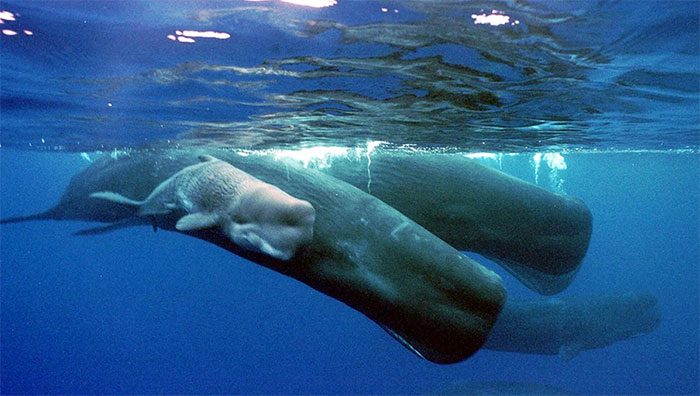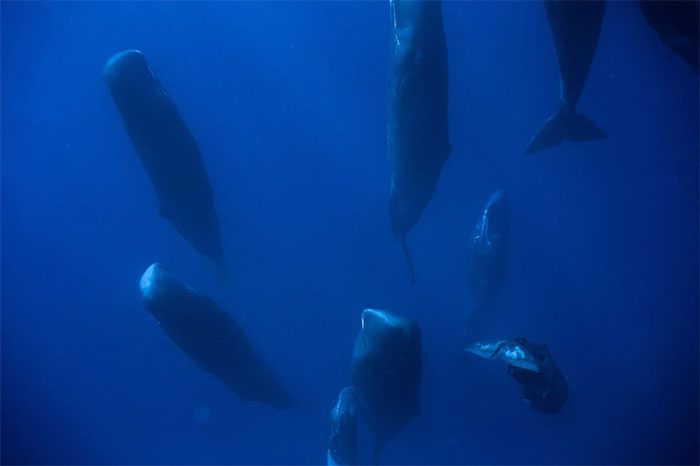Imagine you are a diver leisurely swimming in the ocean. Suddenly, a strange sight appears before you: seven or eight gigantic gray-brown rocks standing upright in a dark sea, forming a circle, as if some sort of Stonehenge has emerged from the water, suggesting that a mysterious ritual is taking place. Surely, many would feel utterly amazed, not knowing what is happening.
How could there be a Stonehenge in the sea? In fact, this sight is a giant pod of sperm whales sleeping.

“Whales don’t need to sleep” is a completely incorrect statement, as many believe that fish cannot sleep underwater. As highly intelligent mammals, sperm whales and dolphins still need to sleep, even though they live in the icy depths of the ocean.
Why do sperm whales use this strange and unique vertical position to sleep? No one knows for sure, and some sperm whales can even sleep in this peculiar suspended position in the ocean, which divers stumbled upon a decade ago.
According to research by scientists, sperm whales only sleep about 7% of their lives, making them one of the mammals with the shortest sleep duration on the planet. Thus, encountering a sleeping sperm whale is an incredibly rare sight.

The sleep of many animal species is very fragmented. For example, horses only need to sleep for 2 hours each day, while giraffes only require about 10 minutes. In contrast, some animals need more sleep due to their habits and specific body structures, such as snakes, frogs, and other creatures that need to hibernate for several months. Sperm whales, on the other hand, only spend about 7% of their lives sleeping in a vertical position. Their napping sessions last from 6 to 25 minutes.
Sperm whales are the deepest diving mammals with super respiratory abilities, allowing them to dive up to 1,000 meters underwater and stay submerged for over an hour. However, when sperm whales sleep, they keep their bodies near the surface, only about ten to twenty meters down. As for why they maintain this unusual sleeping posture, several hypotheses are often proposed.
One reason is that the head of a sperm whale is more buoyant than its tail. The upper part of a sperm whale’s body contains lungs and air sacs, while the lower part is dense with muscle and bone. When they fall asleep in the water, their heads may accidentally rise without them realizing it.

Their heads also contain a large amount of a substance known as ‘spermaceti’.
Some whalers once believed that this oily, viscous substance was whale sperm, but scientists still do not fully understand the actual function of this spermaceti. Another hypothesis suggests that this liquid solidifies when cold, allowing the whale to easily adjust its buoyancy to dive deeper and surface more quickly. Sperm whales are also known to dive deeper than 3,280 feet (nearly 1,000 meters) in search of squid during hunting. Notably, these giant mammals can hold their breath for up to 90 minutes while diving.
Another reason is that lifting their heads allows them to sense light; additionally, when air is insufficient, they can quickly rise to the surface to breathe upon waking.
Another possible reason is that the head of the sperm whale stores spermaceti, which can amount to 2,000 liters. Sperm whales utilize blood circulation or inhale seawater to melt or solidify the oil, changing their density to rise or dive. While sleeping, sperm whales can automatically adjust to this peculiar buoyancy state.

The sleep of sperm whales has been among the earliest subjects of human observation and research in whales and dolphins. Once large sperm whales drift into slumber, they remain upright in the water, and their colossal pillar-like shapes make their sleeping posture resemble giant stone columns floating in the ocean.

Scientists have discovered that whale sleep is extremely fascinating. It appears that almost all whales exhibit typical USWS behavior. USWS (Unihemispheric Slow-Wave Sleep) is an abnormal slow-wave sleep process where one hemisphere of the brain alternately rests while the other remains awake. This contrasts with normal sleep, where both eyes are closed and both hemispheres of the brain temporarily rest.

Overall, humans have not deeply studied the sleep of whales, dolphins, and many other species. All research has only scratched the surface. The reason is that the electroencephalogram analysis method commonly used by humans is difficult to apply to wild animals. Additionally, disturbing animals’ natural living behaviors merely for research purposes is considered unethical.





















































